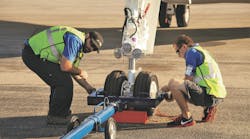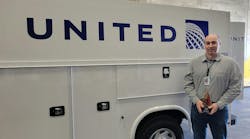Duty Times
Do they apply to you?
By John Goglia
November 1998
As I travel around visiting repair stations and airlines one question seems to get asked more than any other so I thought I would try to update everyone. The concerns that I hear involve FAR 121.377 maintenance and preventive maintenance personnel duty time limitations.
I don't know what could have caused so many mechanics to become so concerned but someone has clearly said something to get the juices flowing. FAR Part 121.377 states within the United States, each certificate holder [or person performing maintenance or preventive maintenance functions for it] shall relieve each person performing maintenance or preventive maintenance from duty for a period of at least 24 consecutive hours during any seven consecutive days, or the equivalent thereof within any one calendar month.
I believe the easiest way to proceed would be to examine the way it is written. First this is an air carrier or 121 rule. This rule only applies to persons who work on aircraft or components that are installed on aircraft that are operated in 121 air carried service. It is important to remember that if the component you are working on is to be installed on an air carrier aircraft then you are governed by 121.377. Those who only work in general aviation are not required to comply with this section.
Next comes the phrase "within the United States." I have been unable to find anyone who knows the history of this caveat. Does this mean that maintenance personnel who work outside the United States don't suffer the effects of fatigue so they do not require any rest periods?
I don't know why this is here but maybe some of the retired FAA folks who read this article can answer this. The next portion of this rule states "a person performing maintenance needs 24 hours off work in every seven days." This 24 hours must be consecutive. The final few words give everyone lots of room to comply with this rule and as some FAA inspectors have told me make this rule virtually unenforceable. The words "or the equivalent thereof within any one calendar month," has been interpreted to mean 4 periods of 24 hours each free from work.
This means you could work 24 consecutive days in a calendar month and then take 4 days off and comply with the provisions of this rule. There is an interpretation made in 1991 that provides some guidance on the intent of this rule. A repair station that works on marine and industrial engines, as well as aircraft engines, asked the FAA the following question: Must a person observe FAR 121.377 if performing similar work tasks on combinations of aircraft engines and marine and industrial engines? When working in some repair stations it could be a common occurrence to work on both aircraft components and industrial products during the course of the workday.
The FAA answer: Section 121.377 would apply. The applicability of FAR 121.377 is not eliminated by a person's performing a mix of work such as you describe. Such an interpretation would defeat the purpose of the regulation which is to insure that person's performing part 121 maintenance or preventive maintenance are provided relief from duty. This answer leaves unanswered a number of additional concerns such as who is responsible for keeping track of the duty time?
With so many employees working part time for the air carrier industry today, does the time spent on another job count in the total duty time and who is responsible for keeping track of this time? The FAA's answer indicating the "purpose of the regulation is to insure......relief from duty" would indicate that all work, regardless of type or location would be included in the duty time computations.
This would present some serious recordkeeping challenges. Some time ago I was involved in proposed enforcement action where a shop mechanic had worked some 35-plus consecutive days which were recorded by the employer and easily checked by the FAA. The proposed action wanted to make any components that this person returned to service unairworthy.
This action immediately got the attention of the most senior management. The FAA settled this without ever addressing the concerns they themselves raised. Given all the research that the FAA has conducted into pilot and air traffic controllers fatigue issues along with the work NASA is doing in these same area, we maintenance folks may not have to wait to long before we see activity from the FAA in this area.





